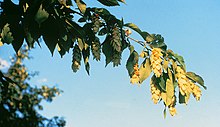
Back Ostrya AN قنابية Arabic قنابيه ARZ Хмеляграб Byelorussian Воден габър Bulgarian Ostrya BS Ostrya Catalan Ostrya CEB Habrovec Czech Humlebøg Danish
| Hophornbeam | |
|---|---|

| |
| Ostrya virginiana | |
| Scientific classification | |
| Kingdom: | Plantae |
| Clade: | Tracheophytes |
| Clade: | Angiosperms |
| Clade: | Eudicots |
| Clade: | Rosids |
| Order: | Fagales |
| Family: | Betulaceae |
| Subfamily: | Coryloideae |
| Genus: | Ostrya Scop. |
| Synonyms[1] | |
|
Zugilus Raf. | |
Ostrya is a genus of eight to 10 small deciduous trees belonging to the birch family Betulaceae. Common names include hop-hornbeam and hophornbeam. It may also be called ironwood, a name shared with a number of other plants.
The genus is native in southern Europe, southwest and eastern Asia, and North and Central America.[1] They have a conical or irregular crown and a scaly, rough bark. They have alternate and double-toothed birch-like leaves 3–10 cm long. The flowers are produced in spring, with male catkins 5–10 cm long and female aments 2–5 cm long. The fruit form in pendulous clusters 3–8 cm long with 6–20 seeds; each seed is a small nut 2–4 mm long, fully enclosed in a bladder-like involucre.[2]
The wood is very hard and heavy. The genus name Ostrya is derived from the Greek word ὀστρύα (ostrúa), which may be related to ὄστρακον (óstrakon) "shell (of an animal)".[3] Regarded as a weed tree by some foresters[who?][citation needed], this hard and stable wood was historically used to fashion plane soles.
Ostrya species are used as food plants by the larvae of some Lepidoptera species, including winter moth, walnut sphinx, and Coleophora ostryae.
- ^ a b Kew World Checklist of Selected Plant Families
- ^ Flora of North America, vol 3, hop-hornbeam, Ostrya Scopoli, Fl. Carniol. 414. 1760.
- ^ "Ostrya". Merriam-Webster.com Dictionary. Merriam-Webster. Retrieved 2019-03-03.